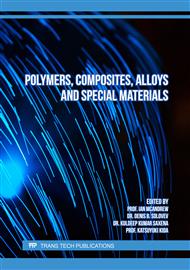[1]
H.N. An, B. Sun, S.J. Picken, E. Mendes, Long time response of soft magnetorheological gels, J. Phys. Chem. B 116 (2012) 4702–4711.
DOI: 10.1021/jp301482a
Google Scholar
[2]
A.K. Bastola, V.T. Hoang, L. Li, A novel hybrid magnetorheological elastomer developed by 3D printing, Mater. Des. 114 (2017) 391–397.
DOI: 10.1016/j.matdes.2016.11.006
Google Scholar
[3]
M. Lokander, B. Stenberg, Performance of isotropic magnetorheological rubber materials, Polym. Test. 22 (2003) 245–251.
DOI: 10.1016/s0142-9418(02)00043-0
Google Scholar
[4]
J.D. Carlson, M.R. Jolly, MR fluid, foam and elastomer devices, Mechatronics 10 (2000) 15.
DOI: 10.1016/s0957-4158(99)00064-1
Google Scholar
[5]
L. Chen, X.L. Gong, W.H. Li, Microstructures and viscoelastic properties of anisotropic magnetorheological elastomers, Smart Mater. Struct. 16 (2007) 2645–2650.
DOI: 10.1088/0964-1726/16/6/069
Google Scholar
[6]
M. Zrinyi, J. Gacs, C. Simon, Magnetic field sensitive polymer gels and uses thereof, Patent WO 9702580 (1996).
Google Scholar
[7]
D. Szabo, G. Szeghy, M. Zrinyi, Shape Transition of Magnetic Field Sensitive Polymer Gels, Macromolecules 31 (1998) 6541-6548.
DOI: 10.1021/ma980284w
Google Scholar
[8]
E.F. Levina, L.S. Mironova, L.V. Nikitin, G.V. Stepanov, Magnetic controllable flexible composite material, Patent RU2157013C2 (1998).
Google Scholar
[9]
L.V Nikitin, L.S. Mironova, G.V. Stepanov, A.N. Samus, The influence of a magnetic field on the elastic and viscous properties of magnetoelastics, J. Polymer Science Ser. A 43 (2001) 443-450.
DOI: 10.4028/www.scientific.net/msf.373-376.453
Google Scholar
[10]
L.V. Nikitin, L.S. Mironova, K. Kornev, G.V. Stepanov, The magnetic, elastic, structural, and magnetodeformational properties of magnetoelastics, Vysokomolekularnye Soedineniya. Ser.A Ser.B Ser.C - Kratkie Soobshcheniya. 46 (2004) 498-509.
Google Scholar
[11]
L.V. Nikitin, G.V. Stepanov, L.S. Mironova, A.I. Gorbunov, Magnetodeformational effect and effect of shape memory in magnetoelastics, J. of magnet. and magnetic mat. 272 (2004) 2072-2073.
DOI: 10.1016/j.jmmm.2003.12.838
Google Scholar
[12]
G.V. Stepanov, A.I. Gorbunov, Magnetoelastic composite: synthesis and properties, Chemical industry today 9 (2005) 25-32.
Google Scholar
[13]
G.V. Stepanov, E.Yu. Kramarenko, Twelve properties of a magnetoactive elastomer, 17th Inter.l Pless Sci. Conf. on Nanodis. Magn. Fluids (2016) 187-197.
Google Scholar
[14]
A. Fuchs, Q. Zhang, J. Elkins, F. Gordaninejad, C. Evrensel, Development and characterization of magnetorheological elastomers, J. Appl. Polym. Sci. 105 (2007) 2497–2508.
DOI: 10.1002/app.24348
Google Scholar
[15]
X.L. Gong, X.Z. Zhang, P.Q. Zhang, Fabrication and characterization of isotropic magnetorheological elastomers, Polym. Test. 24 (2005) 669–676.
DOI: 10.1016/j.polymertesting.2005.03.015
Google Scholar
[16]
Y. Wang, Y. Hu, X.L. Gong, W. Jiang, P. Zhang, Z. Chen, Preparation and properties of magnetorheological elastomers based on silicon rubber/polystyrene blend matrix, J. Appl. Polymer Sci. 103 (2007) 3143–3149.
DOI: 10.1002/app.24598
Google Scholar
[17]
Y. Hu, Y.L. Wang, X.L. Gong, X.Q. Gong, X.Z. Zhang, W.Q. Jiang, P.Q. Zhang, Z.Y. Chen, New magnetorheological elastomers based on polyurethane/si-rubber hybrid, Polym. Test. 24 (2005) 324–329.
DOI: 10.1016/j.polymertesting.2004.11.003
Google Scholar
[18]
S.A. Demchuk, V.A. Kuz'min, Viscoelastic properties of magnetorheological elastomers in the regime of dynamic deformation, J. Eng. Phys. Thermophys. 75 (2002) 396–400.
Google Scholar
[19]
L. Chen, X.L. Gong, W.Q. Jiang, J. Yao, H.X. Deng, W.H. Li, Investigation on magnetorheological elastomers based on natural rubber, J. Mater. Sci. 42 (2007) 5483–5489
DOI: 10.1007/s10853-006-0975-x
Google Scholar
[20]
T.L. Sun, X.L. Gong, W.Q. Jiang, J.F. Li, Z.B. Xu, W.H. Li, Study on the damping properties of magnetorheological elastomers based on cis-polybutadiene rubber, Polym. Testing 27 (2008) 520–526.
DOI: 10.1016/j.polymertesting.2008.02.008
Google Scholar
[21]
I. Agirre-Olabide, P. Kuzhir, M.J. Elejabarrieta, Linear magneto-viscoelastic model based on magnetic permeability components for anisotropic magnetorheological elastomers, J. Magn. Magn. Mater. 446 (2018) 155–161
DOI: 10.1016/j.jmmm.2017.09.017
Google Scholar
[22]
A.V. Chertovich, G.V. Stepanov, E.Y. Kramarenko, A.R. Khokhlov, New composite elastomers with giant magnetic response, Macromol. Mater. Eng. 295 (2010) 336–341.
DOI: 10.1002/mame.200900301
Google Scholar
[23]
T. Tian, M. Nakano, Fabrication and characterisation of anisotropic magnetorheological elastomer with 45° iron particle alignment at various silicone oil concentrations, J. of Intel. Mat. Sys. and Struc. 29 (2017).
DOI: 10.1177/1045389x17704071
Google Scholar
[24]
G. Falkovich, Fluid Mechanics, sec. ed., Cambridge Univ Press, Cambridge, 2018.
Google Scholar
[25]
Information on https://lordfulfillment.com/pdf/44/DS7012_MRF-140CGMRFluid.pdf
Google Scholar


